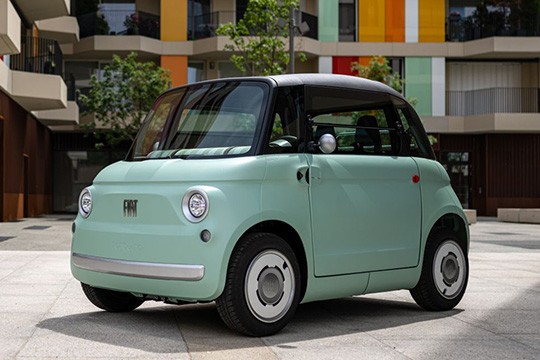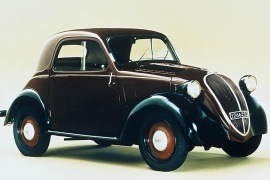FIAT Topolino Models/Series Timeline, Specifications & Photos
First production year: 1936
Engines: Electric, Gasoline
Body style: Coupé (two-door)
The Topolino is a legendary nameplate in Fiat's history, credited by many as the car that saved the Italian brand after World War II. As a result, the carmaker considered bringing it back on the market as an EV in 2023. Just like the 500 Topolino that Fiat made between 1936 and 1955 in more than 500,000 units, the 2023 Topolino was affordable, practical, and easy to use by anyone. In addition, in selected countries, the vehicle could be rented and driven even by people who didn't have a driving license.
Being part of a big automotive group such as Stellantis came with its perks, and one of them was the advantage of shared technology. The micro-vehicle was a badge-engineered Citroen Ami or Opel Rocks. It was not even considered an actual car but an electric quadricycle aimed at customers who needed affordable transportation inside cities. It took the concept of building cheaply at a higher level. Innovative engineering and planning allowed the automaker to create the Topolino/Ami/Rocks with fewer body parts than a regular one. For instance, both doors were molded in the same press. That's why one was hinged at the front while the other was in the back. But Fiat adapted the vehicle's look according to its design language. As a result, the front fascia resembled the old Fiat 500 from the '50s, featuring round headlights and a silver bumper. At the back, the quadricycle had a panel that sported vertical taillights and, as an option, an external rack for a suitcase. But the Italian automaker went even further with personalizing the vehicle. Apart from the canvas folding roof, it offered the possibility to drive the Topolino with the doors removed and passengers secured just by the seat belts and a rope hung between the A- and B-pillars. Worth mentioning that all body panels were made out of composite materials.
The Topolino offered room for two occupants, just like its French and German siblings. Unlike those, it featured padded plastic seats. In front of the driver, the Italian automaker installed a small digital display fitted into a cluster resembling the 1957 Fiat 500 dashboard's design. In addition, customers could install a speaker or a fan plugged-in into a USB socket. There was no infotainment system in the vehicle. Still, customers could use their smartphones along with a dedicated app for that. It could've been connected via the same USB port for accessing more data provided by the quadricycle's onboard computer.
The electric quadricycle was a European vehicle category that allowed anyone over 14 years old to drive them on public roads. In addition, these vehicles had a capped maximum speed of 45 kph (28 mph). Thanks to its 6 kW (8HP) motor, the Topolino had no problem reaching that speed. The battery pack provided 5.5 kWh of energy, enough to provide a range of up to 75 km (47 miles).
Undoubtedly one of the most famous Italian cars, the Fiat 500 “Topolino” was a small car produced by the Turin-based company from 1936 to 1955.
Benito Mussolini, the fascist dictator of Italy, asked the senator Giovanni Agnelli to do what was necessary for a small, economical and cheap car to be produced for the Italians.
With the request forwarded to Fiat, they thought of using the technologies and schemes already used, to avoid development costs. The only problem was that FIAT was not able to supply an adequate product in such a short time, thus they collaborated with a bright student of Giulio Cesare Cappa, Oreste Lardone, who had already created a prototype of a small car.
Fiat decided to go in parallel with designing the model with company’s standards and hired Oreste Lardone to work with a small group of technicians in order to develop his own mechanical theories.
Lardone’s idea was to create a a 4-seat vehicle with a 500 cmc air-cooled twin-cylinder engine with a front-wheel-drive system. The idea was good, thus a prototype was designed. Unfortunately, while being tested, an engine fire forced the occupants to jump out. Lardone was fired and front-wheel-drive was banned by Fiat.
The project was taken over by Dante Giacosa. After months of drawings and calculations, a new prototype came out. The new car had a radiator that was placed above the engine to save the water pump, a 4-cylinder engine with side valves was fitted, as well as other cost saving features were used.
Satisfied with the result, Fiat authorised the creation of the Fiat 500.
On June 15, 1936, the Fiat 500 was put on sale. While the Topolino was a modest car in therms of technology and performance, the prices around twenty times of the average salary of a skilled worker. The Topolino was successful, with 222,000 vehicles in circulation for over 42 million inhabitants, one Fiat 500 for every 200 people.

